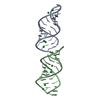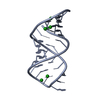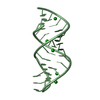+ Open data
Open data
- Basic information
Basic information
| Entry | Database: PDB / ID: 6ymc | ||||||
|---|---|---|---|---|---|---|---|
| Title | 26-mer stem-loop RNA | ||||||
 Components Components | RNA (26-MER) | ||||||
 Keywords Keywords | RNA / tetra-loop | ||||||
| Function / homology | : / RNA / RNA (> 10) Function and homology information Function and homology information | ||||||
| Biological species |  | ||||||
| Method |  X-RAY DIFFRACTION / X-RAY DIFFRACTION /  SYNCHROTRON / SYNCHROTRON /  SAD / Resolution: 2 Å SAD / Resolution: 2 Å | ||||||
 Authors Authors | Janowski, R. / Niessing, D. | ||||||
 Citation Citation |  Journal: Nucleic Acids Res. / Year: 2024 Journal: Nucleic Acids Res. / Year: 2024Title: Intrinsically disordered RNA-binding motifs cooperate to catalyze RNA folding and drive phase separation. Authors: Niedner-Boblenz, A. / Monecke, T. / Hennig, J. / Klostermann, M. / Hofweber, M. / Davydova, E. / Gerber, A.P. / Anosova, I. / Mayer, W. / Muller, M. / Heym, R.G. / Janowski, R. / Paillart, J. ...Authors: Niedner-Boblenz, A. / Monecke, T. / Hennig, J. / Klostermann, M. / Hofweber, M. / Davydova, E. / Gerber, A.P. / Anosova, I. / Mayer, W. / Muller, M. / Heym, R.G. / Janowski, R. / Paillart, J.C. / Dormann, D. / Zarnack, K. / Sattler, M. / Niessing, D. | ||||||
| History |
|
- Structure visualization
Structure visualization
| Structure viewer | Molecule:  Molmil Molmil Jmol/JSmol Jmol/JSmol |
|---|
- Downloads & links
Downloads & links
- Download
Download
| PDBx/mmCIF format |  6ymc.cif.gz 6ymc.cif.gz | 70.7 KB | Display |  PDBx/mmCIF format PDBx/mmCIF format |
|---|---|---|---|---|
| PDB format |  pdb6ymc.ent.gz pdb6ymc.ent.gz | 52.8 KB | Display |  PDB format PDB format |
| PDBx/mmJSON format |  6ymc.json.gz 6ymc.json.gz | Tree view |  PDBx/mmJSON format PDBx/mmJSON format | |
| Others |  Other downloads Other downloads |
-Validation report
| Summary document |  6ymc_validation.pdf.gz 6ymc_validation.pdf.gz | 398.9 KB | Display |  wwPDB validaton report wwPDB validaton report |
|---|---|---|---|---|
| Full document |  6ymc_full_validation.pdf.gz 6ymc_full_validation.pdf.gz | 400.4 KB | Display | |
| Data in XML |  6ymc_validation.xml.gz 6ymc_validation.xml.gz | 5.4 KB | Display | |
| Data in CIF |  6ymc_validation.cif.gz 6ymc_validation.cif.gz | 7.2 KB | Display | |
| Arichive directory |  https://data.pdbj.org/pub/pdb/validation_reports/ym/6ymc https://data.pdbj.org/pub/pdb/validation_reports/ym/6ymc ftp://data.pdbj.org/pub/pdb/validation_reports/ym/6ymc ftp://data.pdbj.org/pub/pdb/validation_reports/ym/6ymc | HTTPS FTP |
-Related structure data
| Similar structure data | Similarity search - Function & homology  F&H Search F&H Search |
|---|
- Links
Links
- Assembly
Assembly
| Deposited unit | 
| ||||||||
|---|---|---|---|---|---|---|---|---|---|
| 1 | 
| ||||||||
| 2 | 
| ||||||||
| Unit cell |
|
- Components
Components
| #1: RNA chain | Mass: 8369.018 Da / Num. of mol.: 2 / Source method: obtained synthetically / Source: (synth.)  #2: Chemical | ChemComp-BA / #3: Water | ChemComp-HOH / | Has ligand of interest | N | Has protein modification | N | |
|---|
-Experimental details
-Experiment
| Experiment | Method:  X-RAY DIFFRACTION / Number of used crystals: 1 X-RAY DIFFRACTION / Number of used crystals: 1 |
|---|
- Sample preparation
Sample preparation
| Crystal | Density Matthews: 2.04 Å3/Da / Density % sol: 39.62 % |
|---|---|
| Crystal grow | Temperature: 292 K / Method: vapor diffusion, hanging drop / pH: 7 Details: 100 mM NaCl, 15 mM BaCl2, 40 mM Na Cacodylate 7.0 44 % MPD, 12 mM spermine tetrahydrochloride |
-Data collection
| Diffraction | Mean temperature: 100 K / Serial crystal experiment: N |
|---|---|
| Diffraction source | Source:  SYNCHROTRON / Site: SYNCHROTRON / Site:  SLS SLS  / Beamline: X06SA / Wavelength: 1 Å / Beamline: X06SA / Wavelength: 1 Å |
| Detector | Type: DECTRIS PILATUS 2M / Detector: PIXEL / Date: Apr 18, 2015 |
| Radiation | Protocol: SINGLE WAVELENGTH / Monochromatic (M) / Laue (L): M / Scattering type: x-ray |
| Radiation wavelength | Wavelength: 1 Å / Relative weight: 1 |
| Reflection | Resolution: 2→50.01 Å / Num. obs: 9048 / % possible obs: 99.9 % / Redundancy: 5.9 % / Biso Wilson estimate: 31.5 Å2 / CC1/2: 0.987 / Net I/σ(I): 13.1 |
| Reflection shell | Resolution: 2→2.05 Å / Redundancy: 5.7 % / Mean I/σ(I) obs: 3.49 / Num. unique obs: 750 / CC1/2: 0.681 / % possible all: 96 |
- Processing
Processing
| Software |
| |||||||||||||||||||||||||||||||||||||||||||||||||||||||||||||||||||||||||||
|---|---|---|---|---|---|---|---|---|---|---|---|---|---|---|---|---|---|---|---|---|---|---|---|---|---|---|---|---|---|---|---|---|---|---|---|---|---|---|---|---|---|---|---|---|---|---|---|---|---|---|---|---|---|---|---|---|---|---|---|---|---|---|---|---|---|---|---|---|---|---|---|---|---|---|---|---|
| Refinement | Method to determine structure:  SAD / Resolution: 2→50 Å / Cor.coef. Fo:Fc: 0.969 / Cor.coef. Fo:Fc free: 0.936 / SU B: 6.846 / SU ML: 0.123 / Cross valid method: THROUGHOUT / σ(F): 0 / ESU R: 0.194 / ESU R Free: 0.181 SAD / Resolution: 2→50 Å / Cor.coef. Fo:Fc: 0.969 / Cor.coef. Fo:Fc free: 0.936 / SU B: 6.846 / SU ML: 0.123 / Cross valid method: THROUGHOUT / σ(F): 0 / ESU R: 0.194 / ESU R Free: 0.181 Details: HYDROGENS HAVE BEEN ADDED IN THE RIDING POSITIONS U VALUES : WITH TLS ADDED
| |||||||||||||||||||||||||||||||||||||||||||||||||||||||||||||||||||||||||||
| Solvent computation | Ion probe radii: 0.8 Å / Shrinkage radii: 0.8 Å / VDW probe radii: 1.2 Å | |||||||||||||||||||||||||||||||||||||||||||||||||||||||||||||||||||||||||||
| Displacement parameters | Biso max: 78.77 Å2 / Biso mean: 31.496 Å2 / Biso min: 15.81 Å2
| |||||||||||||||||||||||||||||||||||||||||||||||||||||||||||||||||||||||||||
| Refinement step | Cycle: final / Resolution: 2→50 Å
| |||||||||||||||||||||||||||||||||||||||||||||||||||||||||||||||||||||||||||
| Refine LS restraints |
| |||||||||||||||||||||||||||||||||||||||||||||||||||||||||||||||||||||||||||
| LS refinement shell | Resolution: 2→2.052 Å / Rfactor Rfree error: 0 / Total num. of bins used: 20
| |||||||||||||||||||||||||||||||||||||||||||||||||||||||||||||||||||||||||||
| Refinement TLS params. | Method: refined / Refine-ID: X-RAY DIFFRACTION
| |||||||||||||||||||||||||||||||||||||||||||||||||||||||||||||||||||||||||||
| Refinement TLS group |
|
 Movie
Movie Controller
Controller



 PDBj
PDBj
































